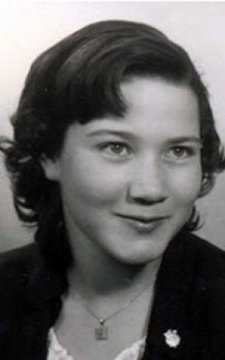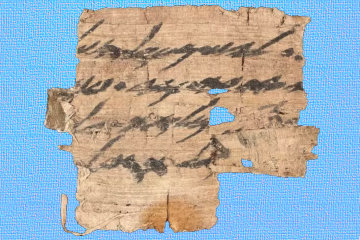Professor Ada Yardeni
Ada Yardeni was born in Jerusalem in 1937 and was only eleven when Israel gained its independence. She would have lived through the traumatic days when the Jewish Quarter of the Old City was besieged and eventually expelled, so she grew up in the Israeli New Jerusalem, where there were constant alarms and tensions as Israel and Jordan faced off over the belt of ruins known as "No Man's Land". UN trucks and soldiers would have been familiar sights to the young girl.

| |
| Ada Yardeni as a young woman. |
After graduating from high school Ada trained as a graphic artist, but her interest strayed from pictures and diagrams to the script in which the new language of Hebrew was written. She began to study the subject and eventually prodced what is, perhaps, her most famous book - "The Book of Hebrew Script", which traces the development of modern Hebrew from its earliest beginnings as proto-Canaanite.
The book quickly became the definitive work on Hebrew writing, drawing on such things as the Gezer Calendar, the Dead Sea Scrolls, and the Siloam Inscription as well as hundreds of other less well-known examples of Hebrew script. To the end of her life she was consulted by other scholars who wanted an authorative opinion on texts they had discovered or were trying to decipher - and she could be quite sharp on those who tried to be smart. For example, some years ago someone tried to suggest that the Siloam Inscription was actually Macabbean or Hellenistic in date. She demolished their claims in an article in BAR (Biblical Archaeology Review) that pulled no punches!

| |
| The Ada Hebrew font designed by Ada Yardeni. |
Using her skills as a graphic artist, in the 1960s she designed her own Hebrew font, which she named after herself - the Ada font. I do not grudge her this bit of self-publicity, as all too often she found herself being side-lined by male colleagues who were only to happy to seek her expertise but rather chary of acknowledging her cooperation in their publications.
Ada married and had two daughters, but her husband died tragically young, leaving his widow to bring up the girls on her own. Perhaps it was having her own children that lead her to do the calligraphy for several Hebrew children's books, or perhaps they were light relief from the more serious scholarship that saw her publish nine books and 59 articles in scholarly journals.
She was involved in deciphering the Ketef Hinnom inscriptions. Gabriel Barkay was investigating ruined tombs in the Hinnom Valley and was working in a chamber that had been used for storing rifles during the Ottoman period. He was not expecting to find anything, but like a good archaeologist he perservered with clearing the tomb. A sharp-eyed assistant noticed that part of the roof had collapsed. When the debris was cleared away, they found a treasure trove of objects.
It appeared that in this tomb the dead had been placed on shelves cut into the stone (arcosolia) but in time, when the body had decayed away, the bones and any other objects were gathered rather unceremoniously and put in a space excavated beneath the shelf. The objects found included pots, needles, bone and ivory objects, bronze arrowheads, glass bottles, a few gold or silver items of jewellery, and, most important of all, two small strips of silver ribbon that had been tightly rolled, a fact that preserved them. (Although lumps of silver, such as rings or earrings, can survive, thin silver such as the ribbons found on the skulls of women buried in the Royal Tombs of Ur, oxidises to a fine, purple powder.)
When the strips were unrolled it was noticed that there was writing scratched into the silver and Ada Yardeni was invited to help read it. She identified it as the so-called "Priestly Blessing", which is found in Numbers 6:24-26. "The Lord bless you and keep you; the Lord make his face shine on you and be gracious to you; the Lord turn his face toward you and give you peace."
The significance of this find cannot be over-stated. Here we have a word-for-word copy of a passage from the book of Numbers, which can be dated to well before the destruction of Jerusalem by the Babylonians in 586 BC. Proponents of various documentary hypothethese claim, with the enormous confidence of the ignorant, that nothing from the Bible existed before the time of Ezra and at most there were oral traditions which were combined by a series of incompetant editors and redactors to make the Bible as we have it today. Here is not just evidence, but proof, that they are wrong.
Ada - by this time Dr Ada Yardeni - was also involved in the investigation of the small ivory pomegranate, which actually turned out to be hippopotamus tooth. The object is about the size of a man's thumb and has, inscribed around the shoulder, a few words which translate as "Holy to the Priest of the House of Yahweh". Despite Ada confirming that the script dates from the 13th century BC, some claimed that it was a later text added to the object by a clever forger.
Part of the pomegranate was broken in antiquity and it was claimed that some of the letters conveniently stopped short of the break. It took examination under a microscope to confirm that the break does cut across some letters - which is what you would expect if the break was through a pre-existing inscription.
According to Exodus 39, the robe worn by the high priest had alternating gold bells and embroidered pomegranates around the hem. Is it possible that a later high priest substituted ivory pomegranates for the applique ones? Others have suggested that it was part of a "sceptre" carried by the high priest as he went about his duties. There is no literary evidence in either Scripture or Josephus for any such object, and a thumb-sized pomegranate is rather small to be the head of such a sceptre!
1 Kings 7 says that Solomon constructed two bronze pillars, known as Jachin and Boaz, which stood in front of the temple. The text says that around the tops of the pillars were two rows of pomegranates. Although the description sounds as if these pomegranates were made of bronze like the rest of the decorations on the pillars, ivory would stand out nicely against the darker bronze! On the other hand, thumb-sized does seem a trifle small to be visible so high up in the air.
More controversially, Dr Yardeni was convinced of the authenticity of the James Ossuary, believed to be the box in which the bones of James, the brother of Jesus, were deposited after he was murdered by the Jews. In an article in the June issue of BAR, Yardeni wrote, "I never doubted the authenticity of the so-called James Ossuary."

| |
| Professonr Smuel Ahituv, who accepted the task of completing Ada Yardeni's book on Hebrew scripts. |
Given the way in which she did not always receive the recognition she deserved, it is nice to be able to record that although she died in 2018, her work lives on. At the time of her death she was working on a book that would be titled, "The National Hebrew Script up to the Babylonian Exile." As her health failed, she turned the work over to her colleagues, Professors Shmuel Ahituv and Mordechai Cogan.
As he went through her extensive notes, Professor Ahituv came across a photograph of a scroll fragment which he did not recognise. Quite properly he informed Eitan Klein, the head of the Israel Antiquities Authorityís Theft Prevention Unit, which was unfortunate because when they eventually tracked the fragment down, it had not been stolen at all!
In 1965 an American woman went out to Jordan as a member of a Christian mission. It is not clear exactly what these people were doing, but this woman became very friendly with both Halil Iskandar Kando, the Bethlehem antiquities dealer who first brought the Dead Sea Scrolls to public attention, and with Joseph Sa'ad, the curator the Rockerfeller Museum. One of these men - and I suspect Kando rather than the museum curator who would, I trust, have professional ethics - presented her with the fragment of scroll. She took it home to Montana, framed it and hung on a wall in her home. When she died, her son inherited and fragmet and, fortunately, kept it instead of sending it to a dump or a charity shop!
It is not clear exactly how the Israeli authorities went about it, but somehow they persuaded this American man (who wishes to remain anonymous) to bring his priceless fragment out to Jerusalem - I suspect an all-expenses paid trip was involved - so that it could be "properly examined". He was shown round the Judean Desert Scroll Departmentís Conservation Laboratory and "decided" that this was where his fragment could be properly conserved and looked after. Frankly, once he had put his fragment in the lions' den, so to speak, I can't see him being allowed to pop it back in his suitcase and fly off to Montana with it!

| |
| The newly discovered "Ishmael" fragment from the First Temple period. |
Subsequently it has been examined epigraphically and dated using C-14, both of which confirm that it is from the late 7th or early 6th century BC - in other words, it is roughly contemporary with the Kefer Hinnom silver scrolls.
Unfortunately it is, indeed, a fragment. There are four lines, of which we have neither the beginings nor the ends. The text appears to be addressed to someone called "Ishmael" and two of the lines read "don't send to" and "of no help" - but what was to be sent and to whom, and why it would not be of any help, we simply do not know.
Nevertheless, even to the untrained eye, it is obvious that the writing is concise and fluent. This no semi-illiterate scrawling by some ham-fisted yokel who has never held a reed pen in his hand before. In other words, just as the Bible portrays, there were plenty of professional scribes around, well able to jot down the words of Jeremiah or the musings of Baruch as well as the less exalted orders of palace functionaries, and it is merely the fact that time is not kind to papyrus which accounts for why we do not have whole libraries of pre-Exilic documents.
Klein makes the arrogant claim that "The legal and worthy place for this artifact is in the IAA Dead Sea Scrolls Unit." I can sympathise with the emotional case for having such objects in Israel, but given the political volatility of that part of the world, I am not convinced that it is the wisest place for these priceless objects to be hoarded. As for the legality, the scroll was found in Jordanian territory, by Jordanian citizens, handled by a Jordanian antiquities dealer, and possibly kept in the Jordanian Rockerfeller Museum, so if it legally belongs anywhere, it should go back to the Jordanians!
© Kendall K. Down 2022





